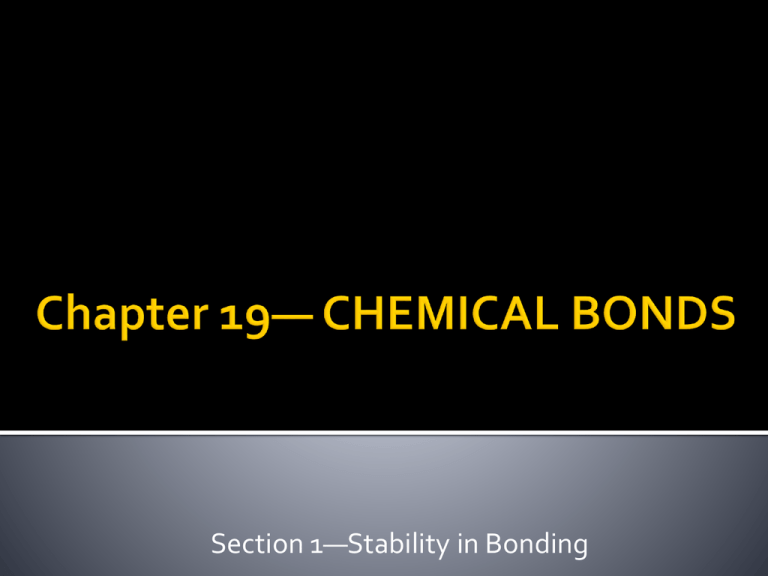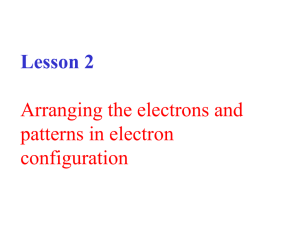Chapter 19*CHEMICAL BONDS
advertisement

Section 1—Stability in Bonding • • Some of the matter around you is in the form of uncombined element, such as copper, sulfur, and oxygen. But, like many other sets of elements, these 3 elements unite chemically to form a compound when the conditions are right. The green coating on the Statue of Liberty and some old pennies is a result of this chemical change. One compound in this coating, is a new compound called copper sulfate. Copper sulfate isn’t shiny and copper colored like elemental copper. Nor is it a pale-yellow solid like sulfur or a colorless, odorless gas like oxygen. Copper sulfate has its own unique properties. SODIUM (SHINY, SOFT, SILVERY METAL) CHLORINE (POISONOUS GREENISH-YELLOW GAS) • • • A chemical formula tells what elements a compound contains and the exact number of atoms of each element in a unit of that compound. EXAMPLE—H2O =CHEMICAL FORMULA H=hydrogen; O=oxygen; and a subscript of 2 = 2 atoms of hydrogen and if no subscript = 1 atom of oxygen H2SO4 = 2 hydrogen atoms 1 sulfur atom 4 oxygen atoms Why do atoms form compounds? Atoms combine when the compound formed is more STABLE than the separate atoms. 115 elements—MOST combine with other elements GROUP 18—the 6 NOBLE GASES seldom form compounds. WHY? • These elements all have 8 electrons in their outer energy level, giving them a COMPLETE outer energy level. EXCEPT He—only 2 electrons, but a COMPLETE outer energy level. • An atom is chemically stable (will not form compounds) when its outer energy level is COMPLETE. He = 2 outer electrons Ne = 8 outer electrons Ar = 8 outer electrons • • • How does that relate to their ability to make compounds? • HYDROGEN contains 1 electron in its 1 energy level. (INcomplete, UNstable) • This is why so many hydrogen containing compounds, including WATER exist on Earth. • • • • In contrast, helium’s outer energy level contains 2 electrons. Helium already has a full outer energy level by itself and is COMPLETE and STABLE. Helium rarely forms compounds, but, by itself, the element is a commonly used gas. • • • Atoms with INcomplete outer energy levels can lose, gain, or share electrons to obtain a STABLE outer energy level. They do this by combining with other atoms that also have partially complete outer energy levels. RESULT: Each achieve stability. • • • • • • Sodium--GROUP 1 1 electron in its outer energy level (INCOMPLETE, UNSTABLE) Chlorine—GROUP 17 7 electrons in its outer energy level (INCOMPLETE, UNSTABLE) • When these atoms combine, sodium loses 1 electron and chlorine gains 1 electron. • RESULT: Sodium and chlorine both receive a COMPLETE and STABLE outer energy level. • • • In the compound water, each hydrogen atom needs 1 electron to fill its outer energy level. The oxygen atom needs 2 electrons for its outer energy level to be stable with 8 electrons. HYDROGEN and OXYGEN share electrons instead of gaining or losing electrons. WATER— H2O •When atoms gain, lose, or share electrons, an attraction forms between the atoms, pulling them together to form a compound. •This attraction or force that holds atoms together is a CHEMICAL BOND. Section 2—TYPES OF BONDS An atom that has LOST or GAINED electrons is called an ion. An ion is a charged particle, because it now has either MORE or LESS ELECTRONS than protons. The POSITIVE and NEGATIVE charges are NOT BALANCED. BEFORE (INDIVIDUAL ELEMENTS): PROTONS = ELECTRONS NOW (GETTING READY TO FORM COMPOUNDS): PROTONS ≠ ELECTRONS Some of the most common compounds are made by the LOSS and GAIN of just 1 ELECTRON. (Group 1 element + Group 17 element) Ex. NaCl Examples…Sodium chloride (table salt); sodium fluoride (anticavity ingredient in toothpaste); and potassium iodide (ingredient in iodized salt) Na LOSES AN ELECTRON Na+ (1 LESS ELECTRON = POSITIVE CHARGE) The 1+ charge is shown as a superscript written AFTER the element’s symbol, Na+, to indicate its charge. F GAINS AN ELECTRONF (1 MORE ELECTRON = NEGATIVE CHARGE) RESULT: The compound has a neutral charge, because positive and negative charges of the ions cancel each other. Ex. NaF (Another Ex. Na+ and Cl NaCl ) An ionic bond is a force of attraction between the opposite charges of the ions in an ionic compound. (Metal + Nonmetal) Ionic bond with more than 1 electron involved… MgCl2 MagnesiumGroup 2 and ChlorineGroup 17 At the same time, 2 chlorine atoms GAIN 1 electron each and become NEGATIVE charged ions, Cl-. A MAGNESIUM atom has 2 electrons to LEND, but a single CHLORINE atom needs to BORROW only 1 electron. Therefore, it takes 2 chlorine atoms to take the 2 electrons from the 1 magnesium ion. Magnesium LOSES 2 electrons = Mg2+ 2 Chlorine atoms GAIN 2 electrons = ClCl(Each Cl atom GAINS 1 electron) The POSITIVE CHARGE of the 1 magnesium ion is exactly EQUAL to the NEGATIVE CHARGE of the 2 chloride ions. ***Therefore, the compound is NEUTRAL. ***Ionic bonds usually are formed by bonding between METALS and NONMETALS (losing/gaining electrons). (Examples: NaCl and MgCl2) Some atoms of NONMETALS are unlikely to LOSE or GAIN electrons. For example, the elements in GROUP 14 have 4 electrons in their outer energy level. They would have to lose or gain 4 electrons in order to have a stable outer energy level. The loss of this many electrons takes a great deal of energy. Each time an electron is removed, the nucleus holds the remaining electrons even more tightly. The attraction that forms between atoms when they SHARE electrons is known as a covalent bond. A neutral particle that forms as a result of electron sharing is called a molecule. O = 6 electrons H = 1 electron H = 1 electron 2 SINGLE COVALENT BONDS N = 5 electrons N = 5 electrons ***3 pairs of electrons represent 3 bonds O = 6 electrons O = 6 electrons ***2 pairs of electrons represent 2 bonds Electrons are not always shared equally between atoms in a covalent bond. The strength of the attraction of each atom ot its electrons is related to… SIZE of the atom CHARGE of the nucleus TOTAL NUMBER OF ELECTRONS the atom contains C = 4 electrons Cl = 7 electrons ***4 Chlorine atoms needed to equally share electrons, so that carbon and chlorine all have 8 electrons in their outer energy levels. CCl4 This type of molecule does not have oppositely charged ends. Section 3—WRITING FORMULAS AND NAMING COMPOUNDS The first formulas of compounds you will write are for binary ionic compounds. A binary compound is a compound that is composed of 2 elements. EXAMPLE—Potassium iodide, the salt additive, is a binary ionic compound. 1. 2. What do you need to know before you can write the formula? Which ELEMENTS are involved? What NUMBER OF ELECTRONS are lost, gained, or shared? (IN ORDER TO BECOME STABLE) An OXIDATION NUMBER tells you how many electrons an atom has GAINED, LOST, or SHARED to become stable. (p. 588) For ionic compounds, the OXIDATION NUMBER is the same as the CHARGE OF THE ION. Na ion Cl ion = = CHARGE 1+ 1- OX. # 1+ 1- • Na = G-1, 1 outer electron (LOSES 1 ELECTRON OR LOSES 1 NEG—CHARGE IS POS) • Cl = G-17, 7 outer electrons (GAINS 1 ELECTRON OR GAINS 1 NEG—CHARGE IS NEG) Although the individual IONS in a compound carry CHARGES, the COMPOUND itself is NEUTRAL. ***A formula must have the right number of POSITIVE IONS and the right number of NEGATIVE IONS so the charges BALANCE. EXAMPLE…Sodium chloride (NaCl) Na+ 1+ Cl10 (Compound is neutral/0 charge) Ca2+ = 2+ F1= 1In this case, you need to have 2 fluoride ions for every calcium ion in order for the charges to cancel and the compound to be NEUTRAL. Ca F 2+ + 1 2+ + 2(1-) 2+ + 2=0 (COMPOUND IS NEUTRAL) 1 ATOM OF Ca and 2 ATOMS OF F; CaF2 Al3+ = 3+ O2= 2What is the least common multiple of 3 and 2? 6 (2 x 3) 2 Al ions and 3 O ions are needed in order to have a 6+ charge and a 6- charge IONS CHARGES Al= 2 x 3+ = 6+ O= 3 x 2= 60 • Therefore, the nuetral compound = • Al2O3 1. 2. Write the symbol of the element or polyatomic ion (ions with more than 1 atom)that has a positive oxidation number or charge. Ex. Na ***H, ammonium ion (NH4), and all metals have positive oxidation numbers. Ex. Na = metal = + Write the symbol of the element or polyatomic ion with the negative oxidation number. Ex. Cl ***Nonmetals (other than H) and polyatomic ions (other than NH4) have negative oxidation numbers. Ex. Cl = nonmetal = - 3. Use subscripts next to each ion so that the sum of the charges is ZERO. Na ion Cl ion = CHARGE 1+ = 1- Ex. Therefore, 1 atom of sodium and 1 atom of chlorine is needed…NaCl Not all compounds are binary (contain 2 elements). Baking soda, used in cooking, has the formula: NaHCO3 Which 4 elements does it contain? Na = sodium H = hydrogen C = carbon O = oxygen poly = many polyatomic = many atoms A polyatomic ion is a positively or negatively charged covalently (nonmetals) bonded group of atoms. 1. You can name a binary ionic compound (2 elements—1 metal and 1 nonmetal) (Using TABLE 2-p.588, check to see if the positive ion is capable of forming more than 1 oxidation number.) Write the name of the positive ion (METAL). Ex. Barium 2. 3. Write the root name of the negative ion (NONMETAL). The root is the first part of the element’s name. (chlorine = chlor-; oxygen = ox) Ex. Fluorine = fluor Add the ending –ide to the root. Ex. BaF2 = Barium fluoride 1. 2. The polyatomic ion in baking soda is the hydrogen carbonate ion. (HCO3-) To name a compound that contains one of these ions… Write the name of the positive ion (METAL). Ex. Sodium Write the name of the negative ion (NONMETALS) TABLE 4—P.591-Hydrogen carbonate (Sodium hydrogen carbonate) Potassium sulfate WRITING FORMULAS FOR COMPOUNDS CONTAINING POLYATOMIC IONS, FOLLOW THE RULES FOR BINARY COMPOUNDS, WITH 1 ADDITION. ***When more than 1 polyatomic ion is needed, write parentheses around them before adding the subscript… Ba2+ ClO31 Ba ClO3 _____________________ 2+ 11 (2+) + 2(1-) (2+) + (2-) = 0 Ba(ClO3)2







